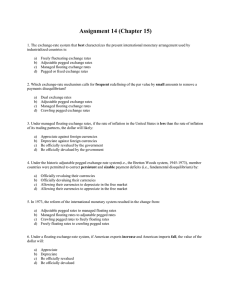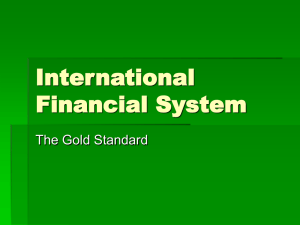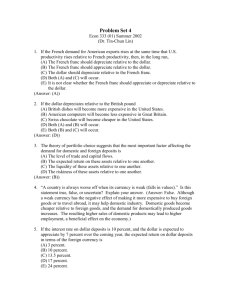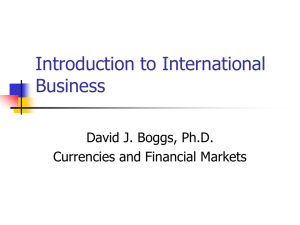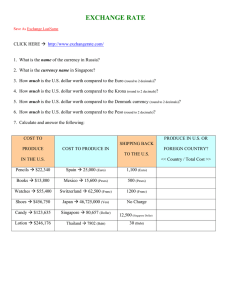CHAPTER 16 EXCHANGE-RATE SYSTEMS MULTIPLE-CHOICE QUESTIONS
advertisement
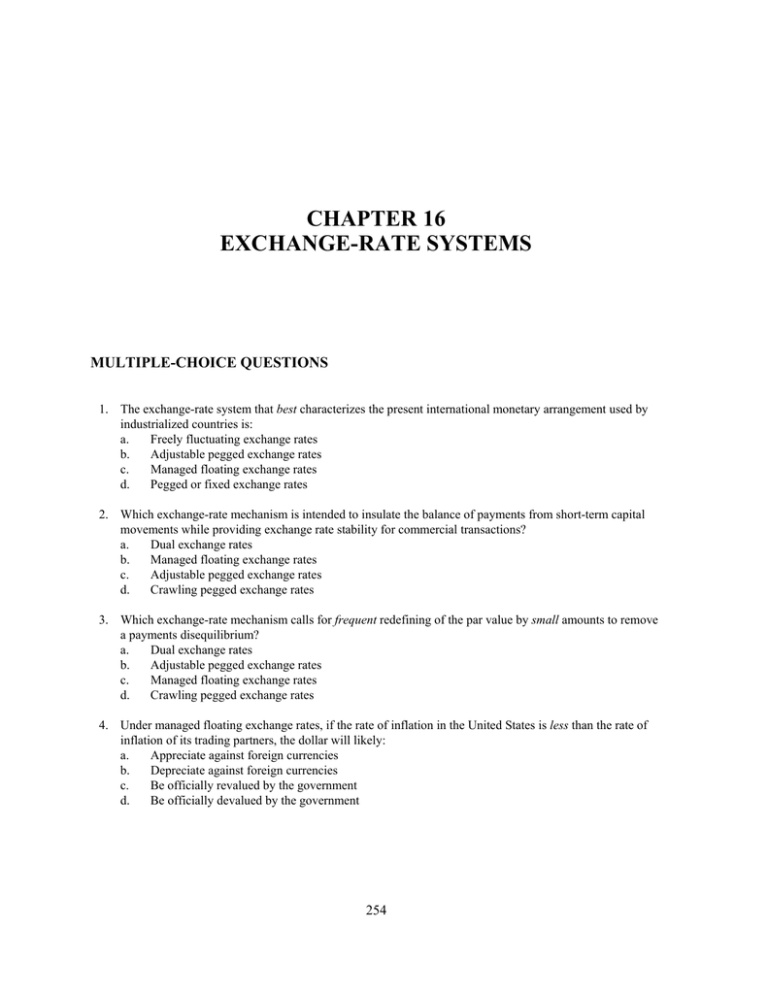
CHAPTER 16 EXCHANGE-RATE SYSTEMS MULTIPLE-CHOICE QUESTIONS 1. The exchange-rate system that best characterizes the present international monetary arrangement used by industrialized countries is: a. Freely fluctuating exchange rates b. Adjustable pegged exchange rates c. Managed floating exchange rates d. Pegged or fixed exchange rates 2. Which exchange-rate mechanism is intended to insulate the balance of payments from short-term capital movements while providing exchange rate stability for commercial transactions? a. Dual exchange rates b. Managed floating exchange rates c. Adjustable pegged exchange rates d. Crawling pegged exchange rates 3. Which exchange-rate mechanism calls for frequent redefining of the par value by small amounts to remove a payments disequilibrium? a. Dual exchange rates b. Adjustable pegged exchange rates c. Managed floating exchange rates d. Crawling pegged exchange rates 4. Under managed floating exchange rates, if the rate of inflation in the United States is less than the rate of inflation of its trading partners, the dollar will likely: a. Appreciate against foreign currencies b. Depreciate against foreign currencies c. Be officially revalued by the government d. Be officially devalued by the government 254 Chapter 16: Exchange-Rate Systems 255 5. Under adjustable pegged exchange rates, if the rate of inflation in the United States exceeds the rate of inflation of its trading partners: a. U.S. exports tend to rise and imports tend to fall b. U.S. imports tend to rise and exports tend to fall c. U.S. foreign exchange reserves tend to rise d. U.S. foreign exchange reserves remain constant 6. Under a pegged exchange-rate system, which does not explain why a country would have a balance-ofpayments deficit? a. Very high rates of inflation occur domestically b. Foreigners discriminate against domestic products c. Technological advance is superior abroad d. The domestic currency is undervalued relative to other currencies 7. Which exchange-rate system does not require monetary reserves for official exchange-rate intervention? a. Floating exchange rates b. Pegged exchange rates c. Managed floating exchange rates d. Dual exchange rates 8. A primary objective of dual exchange rates is to allow a country the ability to insulate its balance of payments from net: a. Current account transactions b. Unilateral transfers c. Merchandise trade transactions d. Capital account transactions 9. During the 1970s, the European Union, in its quest for monetary union, adopted what came to be referred to as the “Community Snake.” This device was a (an): a. Adjustable pegged exchange rate system b. Dual exchange rate system c. Jointly floating exchange rate system d. Freely floating exchange rate system 10. Under the historic adjustable pegged exchange-rate system, member countries were permitted to correct persistent and sizable payment deficits (i.e., fundamental disequilibrium) by: a. Officially revaluing their currencies b. Officially devaluing their currencies c. Allowing their currencies to depreciate in the free market d. Allowing their currencies to appreciate in the free market 11. Which exchange-rate system involves a “leaning against the wind” strategy in which short-term fluctuations in exchange rates are reduced without adhering to any particular exchange rate over the long run? a. Pegged or fixed exchange rates b. Adjustable pegged exchange rates c. Managed floating exchange rates d. Freely floating exchange rates 256 Test Bank for International Economics, 9e 12. In 1973, the reform of the international monetary system resulted in the change from: a. Adjustable pegged rates to managed floating rates b. Managed floating rates to adjustable pegged rates c. Crawling pegged rates to freely floating rates d. Freely floating rates to crawling pegged rates 13. The Bretton Woods Agreement of 1944 established a monetary system based on: a. Gold and managed floating exchange rates b. Gold and adjustable pegged exchange rates c. Special Drawing Rights and managed floating exchange rates d. Special Drawing Rights and adjustable pegged exchange rates 14. Rather than constructing their own currency baskets, many nations peg the value of their currencies to a currency basket defined by the International Monetary Fund. Which of the following illustrates this basket? a. IMF tranche b. Special Drawing Rights c. Primary reserve asset d. Swap facility 15. Small nations (e.g., the Ivory Coast) whose trade and financial relationships are mainly with a single partner tend to utilize: a. Pegged exchange rates b. Freely floating exchange rates c. Managed floating exchange rates d. Crawling pegged exchange rates 16. Small nations (e.g., Tanzania) with more than one major trading partner tend to peg the value of their currencies to: a. Gold b. Silver c. A single currency d. A basket of currencies 17. Under a floating exchange-rate system, if American exports increase and American imports fall, the value of the dollar will: a. Appreciate b. Depreciate c. Be officially revalued d. Be officially devalued 18. Under a floating exchange-rate system, if American exports decrease and American imports rise, the value of the dollar will: a. Appreciate b. Depreciate c. Be officially revalued d. Be officially devalued Chapter 16: Exchange-Rate Systems 257 19. Under a floating exchange rate system, an increase in U.S. imports of Japanese goods will cause the demand schedule for Japanese yen to: a. Increase, inducing a depreciation in the yen b. Decrease, inducing a depreciation in the yen c. Increase, inducing an appreciation in the yen d. Decrease, inducing an appreciation in the yen 20. Given an initial equilibrium in the money market and foreign exchange market, suppose the Federal Reserve increases the money supply of the United States. Under a floating exchange-rate system, the dollar would: a. Appreciate in value relative to other currencies b. Depreciate in value relative to other currencies c. Be officially devalued by the government d. Be officially revalued by the government 21. Given an initial equilibrium in the money market and foreign exchange market, suppose the Federal Reserve decreases the money supply of the United States. Under a floating exchange rate system, the dollar would: a. Appreciate in value relative to other currencies b. Depreciate in value relative to other currencies c. Be officially devalued by the government d. Be officially revalued by the government 22. Under a floating exchange-rate system, if the U.S. dollar depreciates against the Swiss franc: a. American exports to Switzerland will be cheaper in francs b. American exports to Switzerland will be more expensive in francs c. American imports from Switzerland will be cheaper in dollars d. None of the above 23. If the Japanese yen depreciates against other currencies in the exchange markets, this will: a. Have no effect on the Japanese balance of trade b. Tend to worsen the Japanese balance of trade c. Tend to improve the Japanese balance of trade d. None of the above 24. If the Japanese yen appreciates against other currencies in the exchange markets, this will: a. Have no effect on the Japanese balance of trade b. Tend to improve the Japanese balance of trade c. Tend to worsen the Japanese balance of trade d. None of the above 25. Suppose Sweden’s inflation rate is less than that of its trading partner. Under a floating exchange rate system, Sweden would experience a (an): a. Appreciation in its currency b. Depreciation in its currency c. Fall in the level of its exports d. Rise in the level of its imports 258 Test Bank for International Economics, 9e 26. Assume that interest rates in London rise relative to those in Switzerland. Under a floating exchange-rate system, one would expect the pound (relative to the franc) to: a. Depreciate due to the increased demand for pounds b. Depreciate due to the increased demand for francs c. Appreciate due to the increased demand for francs d. Appreciate due to the increased demand for pounds 27. Under a floating exchange-rate system, which of the following best leads to a depreciation in the value of the Canadian dollar? a. A decrease in the Canadian money supply b. A fall in the Canadian interest rate c. An increase in national income overseas d. Rising inflation overseas 28. A market-determined increase in the dollar price of the pound is associated with: a. Revaluation of the dollar b. Devaluation of the dollar c. Appreciation of the dollar d. Depreciation of the dollar 29. A market-determined decrease in the dollar price of the pound is associated with: a. Revaluation of the dollar b. Devaluation of the dollar c. Appreciation of the dollar d. Depreciation of the dollar 30. Which of the following is not a potential disadvantage of freely floating exchange rates? a. They require larger amounts of international reserves than other exchange systems b. Demand schedules for imports and exports may be price speculation c. There may occur large amounts of destabilizing speculation d. Capital movements among nations may be hindered via exchange rate fluctuations 31. Proponents of freely floating exchange rates maintain that: a. Central banks can easily modify fluctuations in exchange rates b. The system allows policy makers freedom in pursuing domestic economic goals c. Inelastic demand schedules prevent large fluctuations in exchange rates d. Inelastic supply schedules prevent large fluctuations in exchange rates 32. A potential disadvantage of freely floating exchange rates is that there would: a. Exist excessive amounts of hedging in the foreign exchange markets b. Be a lack of incentive to initiate exchange arbitrage c. Be excessive amounts of destabilizing speculation d. Exist a devaluation bias in the exchange markets Chapter 16: Exchange-Rate Systems 259 33. Under a floating exchange rate system, if there occurs a fall in the dollar price of the franc: a. American exports to France will be cheaper in francs b. American exports to France will be more expensive in francs c. American imports from France will be more expensive in dollars d. None of the above 34. Under a system of floating exchange rates, a U.S. trade deficit with Japan will cause: a. A flow of gold from the United States to Japan b. The U.S. government to ration yen to U.S. importers c. An increase in the dollar price of yen d. A decrease in the dollar price of yen 35. A potential limitation of freely floating exchange rates is that: a. Countries require a larger amount of international reserves than otherwise b. Countries are unable to initiate economic policies to combat unemployment c. Exchange rates may experience wide and frequent fluctuations d. Demand tends to be highly sensitive to price movements 36. To temporarily offset an appreciation in the dollar’s exchange value, the Federal Reserve could __________ the U.S. money supply which would promote a (an) __________ in U.S. interest rates and a __________ in investment flows to the United States. a. Increase, decrease, decrease b. Increase, increase, decrease c. Decrease, decrease, decrease d. Decrease, increase, decrease 37. To temporarily offset a depreciation in the dollar’s exchange value, the Federal Reserve could __________ the U.S. money supply which would promote a (an) __________ in U.S. interest rates and a (an) __________ in investment flows to the United States. a. Increase, decrease, decrease b. Increase, increase, increase c. Decrease, decrease, increase d. Decrease, increase, increase 38. In a managed floating exchange-rate system, temporary stabilization of the dollar’s exchange value requires the Federal Reserve to adopt a (an) __________ monetary policy when the dollar is appreciating and a (an) __________ policy when the dollar is depreciating. a. Expansionary, expansionary b. Expansionary, contractionary c. Contractionary, expansionary d. Contractionary, contractionary 39. The central bank of the United Kingdom could prevent the pound from appreciating by: a. Selling pounds on the foreign exchange market b. Buying pounds on the foreign exchange market c. Reducing its inflation rate relative to its trading partners d. Promoting domestic investment and technological development 260 Test Bank for International Economics, 9e 40. A surplus nation can reduce its payments imbalance by: a. Applying tariffs and trade restrictions on imports b. Revaluing its national currency c. Increasing its labor productivity d. Setting higher interest rates than its trading partners 41. A main purpose of exchange stabilization funds is to: a. Permit a country to overvalue its currency in the exchange markets b. Permit a country to undervalue its currency in the exchange markets c. Increase the supply of foreign currency when imports exceed exports d. Decrease the supply of foreign currency when imports exceed exports 42. As a policy instrument, currency devaluation may be controversial since it: a. Imposes hardships on the exporters of foreign countries b. Imposes hardships on exporters of the devaluing country c. Is generally followed by unemployment in the devaluing country d. Is generally followed by price deflation in the devaluing country 43. Given a two-country world, assume Canada and Sweden devalue their currencies by 20 percent. This would result in: a. An appreciation in the Canadian currency b. An appreciation in the Swedish currency c. An appreciation in both currencies d. An appreciation in neither currency 44. Suppose that Japan maintains a pegged exchange rate that overvalues the yen. This would likely result in: a. Japanese exports becoming cheaper in world markets b. Imports becoming expensive in the Japanese market c. Unemployment for Japanese workers d. Full employment for Japanese workers 45. To defend a pegged exchange rate that overvalues its currency, a country could: a. Discourage commodity exports b. Encourage commodity imports c. Purchase its own currency in international markets d. Sell its own currency in international markets 46. Given a two-country world, suppose Japan devalues the yen by 20 percent and South Korea devalues the won by 15 percent. This results in: a. An appreciation in the value of both currencies b. A depreciation in the value of both currencies c. An appreciation in the value of the yen against the won d. A depreciation in the value of the yen against the won Chapter 16: Exchange-Rate Systems 261 47. Given a two-country world, suppose Japan revalues the yen by 15 percent and South Korea revalues the won by 12 percent. This results in: a. An appreciation in the value of both currencies b. A depreciation in the value of both currencies c. An appreciation in the value of the yen against the won d. A depreciation in the value of the yen against the won Figure 16.1 shows the market for the Swiss franc. In the figure, the initial demand for marks and supply of marks are depicted by D0 and S0 respectively. Figure 16.1. The Market for the Swiss Franc 48. Refer to Figure 16.1. With a system of floating exchange rates, the equilibrium exchange rate is: a. $0.40 per franc b. $0.50 per franc c. $0.60 per franc d. $0.70 per franc 49. Refer to Figure 16.1. Suppose that the United States increases its imports from Switzerland, resulting in a rise in the demand for francs from D0 to D1. Under a floating exchange rate system, the new equilibrium exchange rate would be: a. $0.40 per franc b. $0.50 per franc c. $0.60 per franc d. $0.70 per franc 262 Test Bank for International Economics, 9e 50. Refer to Figure 16.1. Suppose the United States decreases investment spending in Switzerland, thus reducing the demand for francs from D0 to D2. Under a floating exchange rate system, the new equilibrium exchange rate would be: a. $0.40 per franc b. $0.50 per franc c. $0.60 per franc d. $0.70 per franc 51. Refer to Figure 16.1. Suppose the demand for francs increases from D0 to D1. Under a fixed exchange rate system, the U.S. exchange stabilization fund could maintain a fixed exchange rate of $0.50 per franc by: a. Selling francs for dollars on the foreign exchange market b. Selling dollars for francs on the foreign exchange market c. decreasing U.S. exports, thus decreasing the supply of francs d. stimulating U.S. imports, thus increasing the demand for francs Use the data in Table 16.1 to answer Questions 52 through 54. Table 16.1. The Market for Francs Quantity of Francs Demanded Dollar Price of Francs Quantity of Francs Supplied 600 500 400 300 200 100 0 $0.05 0.10 0.15 0.20 0.25 0.30 0.35 0 100 200 300 400 500 600 52. Refer to Table 16.1. Under a system of floating exchange rates, the equilibrium exchange rate equals: a. $0.15 per franc b. $0.20 per franc c. $0.25 per franc d. $0.30 per franc 53. Refer to Table 16.1. If monetary authorities fix the exchange rate at $0.10 per franc, there would be a: a. Shortage of 200 francs b. Shortage of 400 francs c. Surplus of 200 francs d. Surplus of 400 francs Chapter 16: Exchange-Rate Systems 54. Refer to Table 16.1. If monetary authorities fix the exchange rate at $0.30 per franc, there will be a: a. Shortage of 200 francs b. Shortage of 400 francs c. Surplus of 200 francs d. Surplus of 400 francs 55. Under managed floating exchange rates, the Federal Reserve could offset an appreciation of the dollar against the yen by: a. Increasing the money supply which promotes falling interest rates and net investment outflows b. Increasing the money supply which promotes rising interest rates and net investment inflows c. Decreasing the money supply which promotes falling interest rates and net investment outflows d. Decreasing the money supply which promotes rising interest rates and net investment inflows 56. Under managed floating exchange rates, a central bank would initiate: a. Contractionary monetary policy to offset a depreciation of its currency b. Contractionary monetary policy to offset an appreciation of its currency c. Expansionary monetary policy to offset a depreciation of its currency d. None of the above 57. To offset an appreciation of the dollar against the yen, the Federal Reserve would: a. Sell dollars on the foreign exchange market and lower domestic interest rates b. Sell dollars on the foreign exchange market and raise domestic interest rates c. Buy dollars on the foreign exchange market and lower domestic interest rates d. Buy dollars on the foreign exchange market and raise domestic interest rates 58. To help insulate their economies from inflation, currency depreciation, and capital flight, developing countries have implemented: a Regional trading blocs b. Currency boards c. Central banks d. Regional fiscal policies 59. If Mexico dollarizes its economy, it essentially: a. Allows the Federal Reserve to be its lender of last resort b. Accepts the monetary policy of the Federal Reserve c. Ensures that its business cycle was identical to that of the U.S. d. Abandons its ability to run governmental balanced budgets 60. If Mexico fully dollarizes its economy, it agrees to: a. Print pesos only to finance deficits of its national government b. Use the U.S. dollar alongside its peso to finance transactions c. Have the U.S. Treasury be in charge of its tax collections d. Replace pesos with U.S. dollars in its economy 263 264 Test Bank for International Economics, 9e 61. An objective of the dollarization of the Mexican economy would be to: a. Shield its economy from hyperinflation, currency depreciation, and capital flight b. Allow the Federal Reserve to be its lender of last resort c. Ensure that its monetary policy is independent of the Federal Reserve d. Permit it to benefit from tariffs and subsidies imposed by the U.S. government TRUE-FALSE QUESTIONS T F 1. By the early 1970s, gold had been phased out of the international monetary system. T F 2. Since 1974, the major industrial countries have operated under a system of fixed exchange rates based on the gold standard. T F 3. Today, fixed exchange rates are used primarily by small, developing countries that tie their currencies to a key currency such as the U.S. dollar. T F 4. Smaller nations with relatively undiversified economies and large trade sectors tend to peg their currencies to one of the world’s key currencies. T F 5. Large industrial nations with diversified economies and small trade sectors have generally pegged their currencies to one of the world’s key currencies. T F 6. Small nations, such as Angola and Barbados, peg their currencies to the U.S. dollar since the prices of many of their traded goods are determined in markets in which the dollar is the key currency. T F 7. Many developing nations with low inflation rates have pegged their currencies to the U.S. dollar as a way of allowing modest increases in domestic inflation rates. T F 8. Pegging to a single currency is generally done by developing nations whose trade and financial relationships are mainly with a single industrial-country partner. T F 9. Developing countries with more than one major trading partner often peg their currencies to a group or basket of those trading partner currencies. T F 10. Most developing countries have chosen to allow their currencies to float independently in the foreign exchange market. T F 11. Today, special drawing rights (SDRs) represent the most important currency basket against which developing countries maintain pegged exchange rates. T F 12. The special drawing right is a currency basket of five major industrial country currencies. Chapter 16: Exchange-Rate Systems 265 T F 13. The Australian dollar is currently regarded is the key currency of the international monetary system. T F 14. A “key currency” is one that is widely traded on world money markets, has demonstrated relative stable values over time, and has widely been accepted as a means of international settlement. T F 15. The U.S. dollar is generally regarded as the major “key currency” of the international monetary system. T F 16. Most nations currently allow their currencies’ exchange values to be determined solely by the forces of supply and demand in a free market. T F 17. Under the gold standard, the official exchange rate would be $2.80 per pound as long as the United States bought and sold gold at a fixed price of $35 per ounce and Britain bought and sold gold at 12.5 pounds per ounce. T F 18. The par values of most developing-country currencies are currently defined in terms of gold. T F 19. The purpose of an exchange stabilization fund is to ensure that the market exchange rate does not deviate beyond unacceptable levels from the official exchange rate. T F 20. To keep the pound’s exchange value from depreciating against the franc, the British exchange stabilization fund would sell pounds for francs on the foreign exchange market. T F 21. To keep the yen’s exchange value from appreciating against the dollar, Japan’s exchange stabilization fund would buy yen for dollars on the foreign exchange market. T F 22. The purpose of currency devaluation is to cause the home country’s exchange value to appreciate, thus reducing a balance of trade surplus. T F 23. If Uganda devalues its shilling by 10 percent and Burundi devalues its franc by 5 percent, the shilling’s exchange value appreciates 10 percent against the franc. T F 24. If Uganda sets its par value at 400 shillings per SDR and Burundi sets its par value at 200 francs per SDR, the official exchange rate is 1 franc = 0.5 shillings. T F 25. If Uganda revalues its shilling by 20 percent and Burundi devalues its franc by 5 percent, the shillings exchange value will appreciate by 25 percent against the franc. T F 26. Unlike floating exchange rates, fixed exchange rates are not characterized by par values and central bank intervention in the foreign exchange market. T F 27. Because there is no exchange stabilization fund under floating exchange rates, any holdings of international reserves serve as working balances rather than to maintain a given exchange rate for any currency. 266 Test Bank for International Economics, 9e T F 28. Under an adjustable-pegged system, market exchange rates are intended to be maintained within a narrow band around a currency’s official exchange rate. In the case of fundamental disequilibrium, the currency can be devalued or revalued to promote current-account equilibrium. T F 29. In 1973 the major industrial countries terminated managed-floating exchange rates and adopted an adjustable-pegged exchange rates. T F 30. A “dirty float” occurs when a nation used central bank intervention in the foreign exchange market to promote a depreciation of its currency’s exchange value, thus gaining a competitive advantage compared to its trading partners. T F 31. Under managed-floating exchange rates, market forces are allowed to determine exchange rates in the short run while central bank intervention is used to stabilize exchange rates in the long run. T F 32. Under managed floating exchange rates, central bank intervention is used to offset temporary fluctuations in exchange rates that contribute to uncertainty in carrying out transactions in international trade and finance. T F 33. To offset an appreciation in the dollar’s exchange value, the Federal Reserve can nudge interest rates down in the United States which results in net investment outflows. T F 34. When pursued over the long run, a policy of increasing the domestic money supply to offset an appreciation of the home country’s currency results in inflation and a decrease in home-country competitiveness in key industries. T F 35. At the Maastricht Treaty of 1991, members of the European Community established a blueprint for an Economic and Monetary Union with a single currency and a European central bank overseeing a single monetary policy. T F 36. It is universally recognized that Europe fulfills the conditions of an optimum currency area. 267 Chapter 16: Exchange-Rate Systems ANSWERS Answers to Multiple-Choice Questions 1. 2. 3. 4. 5. 6. 7. 8. 9. 10. 11. 12. 13. c a d a b d a d c b c a b 14. 15. 16. 17. 18. 19. 20. 21. 22. 23. 24. 25. 26. b a d a b c b a a c c a d 27. 28. 29. 30. 31. 32. 33. 34. 35. 36. 37. 38. 39. b d c a b c b c c a d b a 40. 41. 42. 43. 44. 45. 46. 47. 48. 49. 50. 51. 52. b c a d c c d c b c a a b 53. 54. 55. 56. 57. 58. 59. 60. 61. b d a a a b b d a 17. 18. 19. 20. 21. 22. 23. 24. T F T F F F F T 25. 26. 27. 28. 29. 30. 31. 32. T F T T F T F T 33. 34. 35. 36. T T T F Answers to True-False Questions 1. 2. 3. 4. 5. 6. 7. 8. F F T T F T F T 9. 10. 11. 12. 13. 14. 15. 16. T F F T F T T F

